 Website:
by Lassen
Website:
by Lassen
Catalog excerpts

I N TR OD U C I NG TH E BROT HERS M OGENS LA SSEN F LEM M I NG LA SSEN DA NISH F U N CTIO NA LISM BY LA SSEN X K R I STI N E N ORLA NDER ST YLIN G ST O R I E S ST YLIN G ST O R IES ST YLIN G PR OD UCT PAGES TH E CO LLECT IO N OVERVI EW & CO LO URS IN F O R M ATI ON & M EAS UREMENT S
Open the catalog to page 7
by Lassen is a Danish design company that was founded in 2008. The starting point was sole focus on architect Mogens Lassen’s products and history, but later the partnership would include his brother, architect Flemming Lassen’s works, and the formation of an internal design team. by Lassen’s mission is to promote good design, whether historical or contemporary. This is why by Lassen regularly combs the archives, drawers and cupboards to source inspiration for furniture, lamps and home accessories designed by Mogens and Flemming Lassen, but which may not have been put into production. New...
Open the catalog to page 9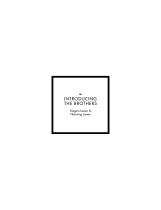
I NTR OD U C I NG TH E B R OTH ERS Mogens Lassen & Flemming Lassen
Open the catalog to page 13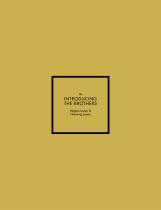
I NTR OD U C I NG TH E B R OTH ERS Mogens Lassen & Flemming Lassen
Open the catalog to page 14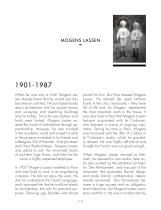
1 901-198 7 painful for him. But Paris shaped Mogens Lassen. He adored the open kitchens found in the city’s restaurants – they were full of life and, for Mogens, represented the most important room in the house. It was also here in Paris that Mogens Lassen became acquainted with Le Corbusier, who became a source of ongoing inspiration. During his time in Paris, Mogens was honoured with the offer of a place in Le Corbusier’s studio, which he gracefully refused. He was highly self-critical and thought his French was not good enough. When he was only a child, Mogens Lassen already knew that...
Open the catalog to page 15
nature, and not the type who cared about becoming rich and famous. He was always sketching – even on Christmas Eve and New Year’s Eve – and he passed away with a pencil in his hand. He loved to retreat to his workroom, which was more of a cave with small pathways carved out between mountains of papers and objects. It was anything but simple and stringent, but he loved the cave’s qualities and the feeling of security it conferred. In fact, he applied this ‘cave’ concept to the houses that he designed, where windows would never face each other directly across the room. Throughout his life as...
Open the catalog to page 16
~ M OG E N S L AS S E N Project for Skovshoved Harbour, 1938
Open the catalog to page 17
M O GEN S LA S S E N Project 'Esbjerg Arena', 1937
Open the catalog to page 21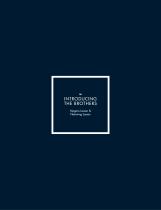
I NTR OD U C I NG TH E B R OTH ERS Mogens Lassen & Flemming Lassen
Open the catalog to page 22
1 902-198 4 Architect Flemming Lassen was a Modernist and was part of the movement to bring Functionalism to Denmark. Flemming Lassen is particularly renowned for his overstuffed furniture, and his arm chairs in particular have recently achieved major international recognition. Today, the auction world uses the term “the Flemming Lassen style” in reference to the designer furniture market. Like his brother Mogens Lassen, Flemming Lassen already knew from a very young age that he would become an architect. He was born into an artistic family with a father who was a decorative painter and a...
Open the catalog to page 23
LEF T S I D E Flemming Lassen with his colleague Arne Jacobsen RIGHT SIDE Flemming Lassen project with Arne Jacobsen ‘'House of the Future’', 1929
Open the catalog to page 27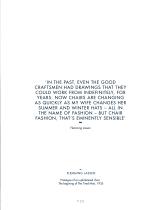
’I N TH E PAST, EVEN T HE GO O D C RA FTS M EN H AD D R AWI NGS T HAT T HEY CO ULD WOR K F R OM I N DEFINIT ELY, FO R Y E AR S . N OW C H AI R S ARE CHA NGING AS QU I C K LY AS M Y WI F E CHA NGES HER S UM M ER AND WI N TER HAT S – A LL IN T H E NAM E OF FAS H I ON – BUT CHA IR FAS H I ON, TH AT’S EM I NENT LY SENSIBLE’ Flemming Lassen F LEM M I N G LA S S E N Prototype of an upholstered chair. The begining of The Tired Man, 1935
Open the catalog to page 29
T HE STORY Architect Mogens Lassen’s classic Kubus candleholder first achieved its final form in 1962, after Lassen spent years fine-tuning an iron prototype that stood on his desk. Next to it was a small steam engine that he would activate when his work came to a standstill – and it would generate new ideas and enable him to forge ahead. He was always filled with a fascination for mechanics and the way things worked and fit together. Mogens Lassen loved to experiment with new shapes and functions; he was a perfectionist and his sense of proportion and mathematics was flawless: Each...
Open the catalog to page 33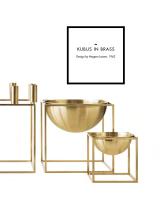
KU B U S IN BRA SS Design by Mogens Lassen, 1962
Open the catalog to page 35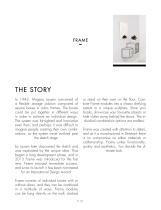
T HE STORY In 1943, Mogens Lassen conceived of a flexible storage solution comprised of square boxes in cubic frames. The boxes could be put together in different ways in order to achieve an individual design. The system was far-sighted and innovative even then, and perhaps it was difficult to imagine people creating their own combinations, so the system never evolved past the sketch stage. by Lassen later discovered the sketch and was captivated by the unique idea. Thus began a long development phase, and in 2013 Frame was introduced for the first time. Frame enjoyed immediate success, and...
Open the catalog to page 37
T HE STORY Architect Flemming Lassen designed the overstuffed easy chair, The Tired Man, for The Copenhagen Cabinetmakers’ Guild Exhibition in 1935. It is characterised by organic, bearlike shapes and, then as now, it created a sensation with its curved form and voluminous armrests. Sitting in the chair should, in Flemming Lassen’s own words, be “as warm and safe as a polar bear cub in the arms of its mother in the middle of the ice cap”. The family man Flemming Lassen valued intimate relationships; with its warm exterior, The Tired Man invokes domestic cosiness and socialising by...
Open the catalog to page 41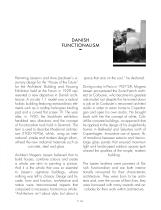
DANI S H F U NCTI ON ALISM Flemming Lassen’s and Arne Jacobsen’s visionary design for the “House of the Future” for the Architects’ Building and Housing Exhibition held at the Forum in 1929 represented a new departure in Danish architecture. A circular 1:1 model was a radical holistic building featuring extraordinary elements such as a rooftop helicopter landing pad and a curved flat screen TV. The year after, in 1930, the Stockholm exhibition heralded new directions and the concept of Functionalism took hold in Denmark. The term is used to describe Modernist architecture (1930-1970s),...
Open the catalog to page 47All By Lassen catalogs and technical brochures
-
LASSEN CHAIR
8 Pages
-
VILHELM
2 Pages
-
INGEBORG
2 Pages
-
STRINGENT Playfulness
136 Pages
-
Frame
15 Pages
-
KUBUS COLLECTION
28 Pages
-
THE TIRED MAN
7 Pages
-
Hallway
3 Pages
-
Conekt Bench
1 Pages
-
KUBUS
1 Pages
-
ANOON DRIKSTROLLEY
1 Pages
-
TWIN
1 Pages
-
News AW2017
44 Pages
-
Catalogue SS17
75 Pages
-
by Lassen Catalogue 2017
148 Pages
-
Catalogue 2016
132 Pages
-
Katalog SS 2015
67 Pages


















